Displaying items by tag: Maintenance Men
Numbering a handful of men that still tend Ireland's lighthouses, but a move, writes Independent.ie, to renewable energy is bringing their unique way of life to an close.
'I can think of no other edifice constructed by man as altruistic as a lighthouse," George Bernard Shaw once said. "They were built only to serve."
Even after the leap in navigational technology represented by GPS, they maintain that historical function: shining a light for miles around, warning sailors and ships of dangers lurking beneath the surface.
The way they are powered is changing, though, and with it the work of the people who tend them.
The tradition of constantly manned lighthouses ended on March 24, 1997, but the lightkeepers' cottages are still inhabited for weeks at a time by maintenance staff who service the lights' diesel-powered motors.
Today, Irish Lights workers travel to sites including Fastnet Rock off Co Cork, Tuskar Rock off Co Wexford, Inishtrahull Island off Co Donegal, Slyne Head off Clifden in Co Galway and Kish Tower in Dublin Bay.
By 2025, however, all lighthouses, beacons and buoys dotted around the coast and in Irish waters will be powered by renewables. The amount of work for technicians who stay at remote lighthouses will fall.
To read more here including from Yvonne Shields O'Connor, chief executive of Irish Lights which is withdrawing from lighthouses' accommodation quarters.
























































